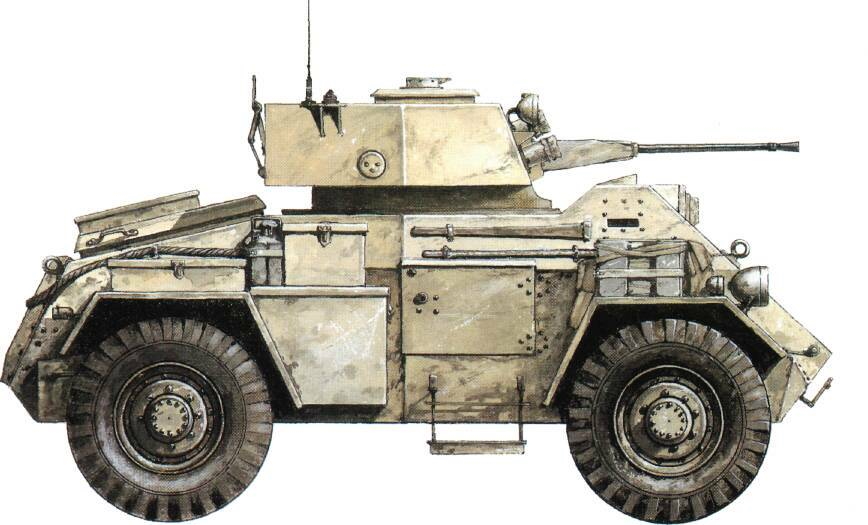
A Humber Armoured Car Mk II, one of the few armoured vehicles to use the 15-mm (0.59-in) Besa heavy machine-gun as its main armament. Originally known as a wheeled tank, these vehicles gave sterling service in many theatres through the war.
The Humber armoured cars were numerically the most important types produced in the United Kingdom, for production eventually reached a total of 5,400, The type had its origins in a pre-war Guy armoured car known as the Tank, Light, Wheeled Mk I, of which Guy produced 101 examples by October1940. In that month it was realized that Guy’s production facilities would be fully occupied producing light tanks, so production was switched to the Rootes Group and Karner Motors Limited of Luton in particular. There the Guy design was rejigged for installation on a Karrier KT 4 artillery tractor chassis, Guy continuing to supply the armoured hulls and turrets. Although the new model was virtually identical to the original Guy design it was subsequently re-named the Armoured Car, Humber Mk I.
The Humber Mk I had a relatively short wheelbase, but it was never manoeuvrable and used a welded hull. The turret mounted two Besa machineguns, a heavy 15-mm (0.59-in) and a lighter 7.92-mm (0.31-in) weapon, The type had a crew of three: a commander who acted as his own wireless operator, a gunner and the driver in the front hull. The first production batch ran to 500 vehicles before the Armoured Car, Humber Mk II introduced some improvements, mainly to the front hull which had a pronounced slope. The Armoured Car, Humber Mk III had a larger turret that allowed a crew of four to be carried, while the Armoured Car, Humber Mk IV reverted to a crew of three as the turret housed an American 37-mm ( 1.45-in) gun. An odd feature of this vehicle was that the driver was provided with a lever which raised a hatch covering an aperture in the rear bulkhead for use as rear vision in an emergency.
The first Humber armoured cars were used operationally in the North African desert from late 1941 onwards, while the Humber Mk IV did not see service until the early stages of the Italian campaign, but thereafter all four marks were used wherever British and Allied troops fought in Europe. A version was produced in Canada with some changes made to suit Canadian production methods. This was known as the Armoured Car, General Motors Mk I, Fox I, and the main change so far as the troops in the field were concerned was that the main armament was a 12.7mm(0.5-in) Browning heavy machine-gun plus a 7.62 mm (0,3-in) Browning medium machine-gun. There was also an extensive conversion of the Humber Mk III as a special radio carrier known as a Rear Link vehicle. This had a fixed turret with a dummy gun. Another radio-carrying version was used as a mobile artillery observation post, and numbers of Canadian Foxes were converted for this role. A later addition to many Humber armoured cars was a special antiaircraft mounting using Vickers ‘K’ machine-guns that could be fired from within the turret; this mounting could also be used with Bren Guns. Smoke dischargers were another operational addition. A more extreme conversion was made with the Armoured Car, Humber, AA, Mk I, which had four 7.92-mm (0.31-in) Besa machine-guns in a special turret. These were introduced during 1943 at the rate of one troop of four cars for every armoured car regiment, but they were withdrawn during 1944 as there was no longer any need for them.
Humber Armoured Cars, Mark III and Mark IV, U. K.
Humber Armoured Cars were numerically the most important British-built armoured cars of World War II, well over 5,000 being produced by the Rootes Group between 1940 and 1945. The earliest Humber Armoured Car, the Mark I, was almost identical externally to the Guy Mark IA Armoured Car, and its mechanical layout although based, of course, on Rootes components was on similar lines to that of the Guy. Service experience suggested improvements and a cleaned-up front end, incorporating the driver’s visor in the glacis plate, and radiator intake improvements were introduced in the Mark II. The Armoured Car, Humber Mark III, which entered production in 1942 had a roomier turret than the Marks I-II, which allowed the crew to be increased to four. The first three Marks of Humber Armoured Car all had an armament of two Besa machineguns, one of 7.92-mm. calibre and the other 15-mm. The latter was never an entirely satisfactory weapon, being prone to stoppages, and in the Humber Mark IV Armoured Car the American 37-mm. gun was introduced in its place. Because this reduced the turret space available, the crew was reduced to three men. All the Humber Armoured Cars weighed about 7 tons and their 90- b. h. p. six-cylinder engines gave them a top speed of 45 m. p. h. They were used by both armoured car regiments (where they tended to be used at regimental and squadron headquarters if Daimlers were also available) and Reconnaissance Regiments (of infantry divisions) in most theatres of war in which British and Commonwealth troops were engaged up to the end of the war. The illustrations show a Mark III as it appeared in the North African desert about 1942, and a Mark IV of 1st Reconnaissance Regiment in Italy in 1944.
After 1945 many Humber armoured cars were sold or otherwise passed to other armies. Some were still giving good service to armies in the Far East as late as the early 1960s.